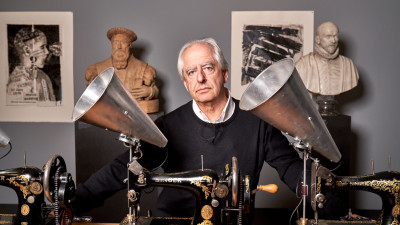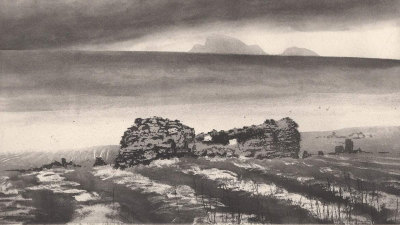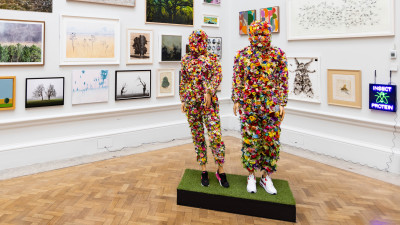Inside the 2019 Summer Exhibition
Inside the 2019 Summer Exhibition
By Michelle Doyle
Published 19 July 2019
Zip around this year’s Summer Exhibition from the comfort of your phone and sample the myriad ways artists are responding to climate change, sustainability, identity politics – and teacakes.
-
It’s happened every year since 1769 and hosted some madcap moments in the history of art; be it Turner, Constable (and their legendary standoff), or suffragette Mary Wood attacking a portrait of Henry James with a meat cleaver. This year’s entrants aren’t nearly as hot-tempered thankfully, but in the spirit of the Summer Exhibition they range from world-famous artists to a ten-year-old who submitted a self-portrait with his cat.
And before you ask…These aren’t in numerical order because (for those of you wondering about our number skills) neither are our galleries!
-
-
Wohl Central Hall
Lions, tigers and bears – this year’s Summer Exhibition kicks off with a menagerie of wild beasts, endangered animals and adorable critters (the “beast” theme also rears its head again in Gallery IX. More on that later).
This wild, fierce, imagined space, devised by our coordinator, Jock McFadyen RA, plays on the popularity of “pet paintings” in the Summer Exhibition while making a point about human impact on the natural world. Perhaps overfishing and deforestation come to mind, but look closely and you’ll also see artists responding to national sovereignty, scientific manipulation and climate change.
Keep an eye out for the Mach brothers’ life-sized tiger too, it’s gilded in teacake wrappers.

-
-
-

Gallery III
This is our largest gallery (and probably the single most challenging space in the Summer Exhibition – not that this deterred Jock McFadyen RA, who curated it). He mixed painting with photography and devised spaces where abstraction and figuration appear side by side.
Each wall has been anchored around a large work, whether desolate wastelands and housing blocks, or a ghostly warship floating on the sea.
-
-
-
Gallery II
Mosey into Gallery II where you’ll find a diptych made of mud from the river Avon. This was the first work selected for Gallery II, and the room unfolded intuitively from there with no particular theme in mind, according to curator, Richard Wilson RA.

-
-
-

Gallery I
A banner emblazoned with “We are all immigrant scum” might be the first thing you notice as you pass into Gallery I, but it’s by no means the only work challenging our understanding of identity, immigration and borders. Jane and Louise Wilson RA reflect on marginalised groups, split identities, ecological threats and feminism, opting for works that create a dialogue with each other.
-
-
-
Large Weston Room
And… are those trees I see? If sustainability and architecture are your thing then look out for the Large Weston Room, which is arranged around a grove of trees that absorb carbon dioxide. Nifty, right?

-
-
Gallery IV takes a broad look at the way the human race is enabling the destruction of the planet.
Barbara Rae RA
-
-

Gallery IV
But the ecological theme doesn’t end at the Large Weston Room. As Barbara Rae RA, Curator of Gallery IV told us; “My selection for the gallery was inspired by the four trips I made to the Arctic where I encountered the effects of global warming and human pollution firsthand.
“I saw how the growing availability of non-native foods and hardware in the Arctic creates problems around disposal. This gallery, subsequently, takes a broad look at the way the human race is enabling the destruction of the planet.”
-
-
-
Gallery V
Barbara Rae also co-curated Gallery V with Hughie O’Donoghue RA, and the wonders of the natural world abound here, with atmospheric skies, swarming bees and flocks of birds.
But it’s perhaps Dorothy Cross’s luminescent prints that best capture the fragility of living things. Printed with ink containing particles that are ‘charged’ by daylight, Cross’s prints glow in the dark and slowly fade as time passes.

-
-
The room took shape not by design but intuitively. I suddenly realised that some little corner had assembled figures with both arms raised, and above them more figures, but with both arms lowered.
Timothy Hyman RA
-
-

Gallery VI
Over in Gallery VI, Timothy Hyman RA wanted to make drawing a focus, “as it’s a medium that’s been absent from previous Summer Exhibitions,” he told us.
But his room also took shape intuitively: “I suddenly realised that some little corner had assembled figures with both arms raised, and above them, more figures with both arms lowered. To my surprise I found this play of images enormously enjoyable.”
“I also love that newly-exhibiting young artists, some of them completely unknown to me, could jostle with established figures in their seventies, eighties and even nineties,” Hyman adds. “I gave prominence to the eight-foot Wishing Tree by the 79-year-old Peter Darach, but across the arch was 30-year-old Melissa Kime’s beautiful swimming-pool fantasy of boys and testicles. I also pay tribute to my 96-year-old mentor, Jeffery Camp, as well as several former students whose work I’ve come to admire.”
-
-
-
Gallery VII
Likewise, printmaker Anne Desmet didn’t come at Gallery VII with a particular theme: “I was just looking for beautifully crafted work with a strong character. But when it came to the hanging, strong links became apparent, which gave the room coherence and clarity.
“One wall, for instance, features abstract works in tonal greys, mixed with detailed views of urban tower blocks – which in that context take on abstract qualities themselves – while another features black and white etchings, mostly of urban architecture.“

-
-
"As I pored over the submissions, this idea of a cosmic room took hold."
Bob and Roberta Smith RA
-
-

Gallery VIII
Gallery VIII takes an abstract approach. As the curator, Bob and Roberta Smith RA, explained: “some people think abstract art isn’t about the subject; they think it’s about form. Yet so much of the abstract work submitted this year was about an ineffable world of spatial and colour relationships defined, on one hand by maths, and on the other by the cosmos.
"I invited a number of artists who explore art’s relationship with science, like Haroon Mirza, whose work hacks into technology. As I pored over the submissions, this idea of a cosmic room took hold. I also looked at artworks that are not abstract but refer to God – Chinwe Ibe Russell’s painting charts the journey of her mother who was taught by nuns in Nigeria.”
Can he pick a favourite?
“I’ve fallen in love with all the works in Gallery VIII but if I’m pressed, I’d direct you to two quiet monochrome works by Barbara Walker. Barbara points out how, in the history of Western art, black people populate Old Master paintings; they are there – but rarely in positions of power. One more: a full-blown masterpiece and the centrepiece of Gallery VIII is a work by Frank Bowling who, along with Lubaina Himid and Chris Ofili, is one of our greatest living artists.”
Why did he paint one wall red? “Because red is cosmic, dude!”
-
-
-
Gallery IX
In Gallery IX, painter Hughie O’Donoghue RA ties together a number of strands; Van Gogh’s tragic life and death play a significant part; while in a mantelpiece-style display, humour abounds – just look at Toby Ursell’s Study for a Picasso Emoji. O’Donoghue also dedicated a large section to women exploring the female form and reshaping traditional visual narratives.
Benedict Byrne’s two-tonne, limestone sculpture, The Scarred One is a key work, which faces O’Donoghue’s painting of Van Gogh. He tells us: “Van Gogh was also a scarred one – as everyone knows he cut off his ear off on Christmas eve in 1888. This connection made me think about a theme that was dear to Van Gogh: Emile Zola’s La Bête humaine (or “The Human Beast”) which is about the beast within humanity.”
However, movement is also at the heart of his selection. Janet Mullarney’s dancer “has a lot of movement to it,” creating an “interesting relationship with Eileen Cooper RA’s paintings behind.”

-
-
-

Lecture Room
In the Lecture Room, Stephen Chambers RA brought together a variety of work which he ties together through subtle colour features. He plays freely with his selection, anchoring the space with his own innovative hanging techniques – such as the diagonal dialogue he creates between Olwyn Bowey RA’s two works which are hung at the same level in opposite corners.
-
-
-
Ronald and Rita McAulay Gallery
Honorary Royal Academician Wim Wenders has been an active photographer since the 1960s. His photography is inextricably linked to his cinematography and his work interrogates its subjects – nature, urban scenes – to determine what they have “to tell”. These photographs selected for the Summer Exhibition are printed on a large scale and in doing this, Wenders intended to put the viewer in the position he experienced when he took the shot.

-
-
-
Visit the Summer Exhibition
You’ve taken our virtual tour of the Summer Exhibition; now it’s time to see the works in the flesh.
Book your tickets today and see the RA’s largest Summer Exhibition in over a century.

-
-
Want to see the Summer Exhibition for free?
-
Shop the range

















